This seems like a good week to switch (temporarily) from baseball to football.
I’m not going to talk much about the current Chiefs. They are awesome, but well covered by the KC Star, The Athletic, etc. I’m going with nostalgia – the golden-oldies Chiefs who played at Municipal Stadium at 22nd and Brooklyn.
The story starts in Dallas.
The Dallas Texans: In 1959, there were no pro football teams in Dallas. In 1960, the city had two: (i) the Cowboys, an NFL expansion team, and (ii) the Texans, a charter member of the new 8-team American Football League. The Texans were founded by Lamar Hunt, and he hired Hank Stram as the team’s first coach.
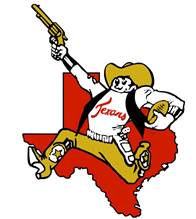
In 1962, the team signed 27-year-old quarterback Len Dawson who had played sparingly in five years in the NFL. Dawson worked well with Stram and had an MVP year, leading the team to the AFL Western Division title. The running stars were Abner Haynes and Rookie-of-the-Year Curtis McClinton. The top receiver was split end Chris Burford, a 1960 first round pick, who caught 12 touchdown passes in 11 games (a franchise record that held up until Dwayne Bowe caught 15 TDs in 16 games in 2010). Another top receiver was rookie tight end Fred Arbanas who after his playing days became the longest-tenured member of the Jackson County Legislature.
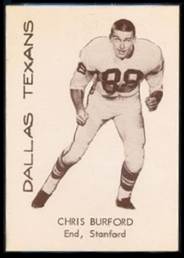
The Texans met the Houston Oilers in the 1962 AFL championship and won a double overtime victory (20-17). The game time of 77 minutes and 54 seconds made it the longest game in pro football history (until Christmas Day of 1971 – more on that below).
But success on the field was not enough for the Texans. Dallas could not support two pro teams, and so Lamar Hunt started looking for a new city. He was considering cities like Atlanta, Miami and New Orleans, but he became intrigued by an offer extended by Mayor H. Roe “Chief” Bartle of Kansas City. In a secret meeting in KC, Hunt liked what he heard about stadium improvements and guaranteed season ticket sales. The persistent Bartle would not be denied.
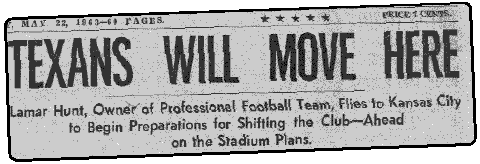
The Kansas City Chiefs: The team was renamed the Chiefs after a fan contest favored honoring “Chief” Bartle for his work in luring the team to KC. The nickname “Chief” dated back to 1925 when Bartle founded the Tribe of Mic-O-Say, an honorary organization associated with boy scout camping. In the tribe, he was Chief Lone Bear. From 1928 to 1955, he led the Kansas City Area Council for the Boy Scouts. Bartle was mayor from 1956 to 1963.
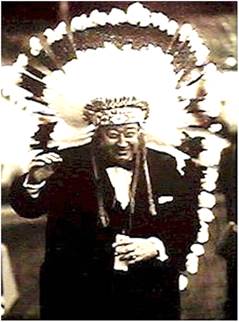
[H. Roe Bartle Trivia: I’m sure that there are Hot Stove readers who have been to Camp Osceola and are Mic-O-Say members. I was part of that world in Troop 263 where I became an Eagle Scout. For five summers, I headed to Osceola with my troop for a 10-day camp. When I was 14 and in my fourth year at Osceola, I was “called” to join the Tribe of Mic-O-Say. “Call” night came while hundreds of scouts gathered on stands around a general campfire to listen for the names of those to be honored. When called, we left our seats and went to the ring around the campfire. We were given instructions about the initiation process which included being on “silence” for the next 24 hours and camping on our own that night. Then a scout leader came up, grabbed you by the arms, and yelled at you “Do you understand me?” He was making sure we knew the initiation rules. I, like most, said “yes.” That was bad. After all, I was on silence. What was I doing talking already? The next yell was a demand to “Leave this council ring!” which was aided by physically throwing us out to spend our lonely night in the woods. Sorry this is such a long story, but it’s necessary for the punchline. The leader who shook me hard, yelled loudly with a booming voice, and threw me out of the council ring, was H. Roe Bartle, a/k/a Chief Lone Bear.]
The Stadium: The Chiefs would be playing in Municipal Stadium which had been renovated and expanded in 1955 when the Kansas City A’s came to town. Mayor Bartle agreed to expand seating for football, and most of this was accomplished with about 11,000 temporary seats in the “North Stands” running from left field into center field on the baseball layout. The team benches were directly in front of the North Stands. The clamorous fans seated there became known as the “Wolfpack.” The Kansas City Star said of the Wolfpack, “Members are known for their football fervor and the acidity of their displays.” Lamar Hunt picked up on that fervor and approved a marketing campaign called “Join the Wolfpack.”
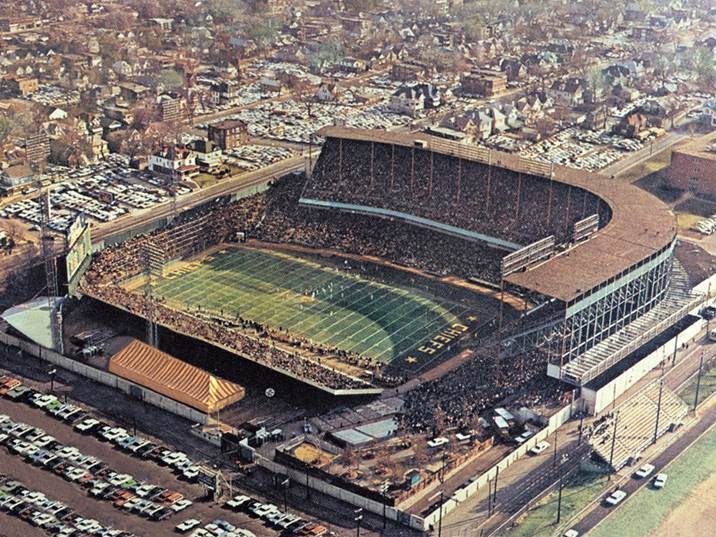
The Scoreboard – Relocatin’ to Kansas City: Our town got its football and baseball teams from cities where two teams could not profitably coexist: the A’s from Philadelphia and the Texans from Dallas. That scenario also applied to the scoreboard at Municipal Stadium. Boston had two MLB teams for decades, but the Braves moved to Milwaukee in 1953. They left behind their 68-foot tall scoreboard which had been added to Braves Field in 1944. It featured a 3-D Chesterfield cigarette ad.
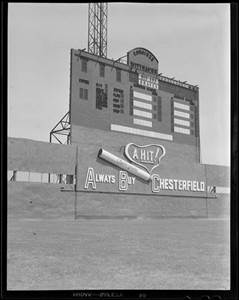
Before the 1955 season, Arnold Johnson bought the Philadelphia A’s and moved the team to Kansas City. The Braves scoreboard also moved that year, joining the A’s at Municipal Stadium. I first saw this scoreboard on opening day in 1955 when I cut school with eighth-grade pal Jay DeSimone to welcome major league baseball to Kansas City. And for many games after that, including the first four Royals seasons from 1969 to 1972.
The scoreboard was modified for use during Chiefs games. In the photo below, the North Stands are in the left foreground. After the Royals moved to the Truman Sports Complex in 1973, the old Braves scoreboard was involuntarily retired (presumably demolished with the rest of the stadium in 1976).
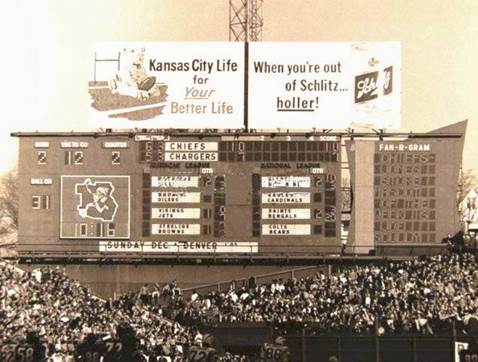
1963-1966 at Municipal Stadium: I was in college and law school for the first four years the Chiefs were in KC. My budget (both dollars and time) did not include the luxury of attending Chiefs games, but I followed them closely and became a big fan. The team generated a passionate following, possibly enhanced by owner Lamar Hunt being a welcome antidote to Charlie Finley, the owner of the other occupant of the stadium.
[Chris Burford Trivia: When I started law school in the fall of 1964, I attended a rush party for the Phi Alpha Delta law fraternity. It was a big event held in the Brown Bottle room at the Schlitz brewery. In the crowd of members and alumni, I met two who I ranked as big-time celebrities: former Supreme Court Justice Charles Whittaker and Chiefs split end Chris Burford. Chris had started law school in KC after the team moved from Dallas. He was in his senior year and clerking at the Popham firm. Coincidentally, three years later, we would overlap for a while when I joined the Popham firm after graduation. Chris went on to a successful law practice in California, including a stint as general counsel to the Pac-10. He is now retired and devotes some of his time reading long Hot Stove posts.]
Although the team had won the AFL title in Dallas in 1962, they got off to a slow start in Kansas City. The Chiefs had mediocre records the first three years and failed to make the playoffs. But they came alive in 1966 to finish 11-2 and win the Western Division. The good news for me was that I got to attend some games through the good graces of my high school friends Bill Lochman and Jim Graham. They had purchased discounted season tickets from their employer, the Kansas City Star. My mind is fuzzy on this, but I think it was $7 per ticket. Their seats were in the North Stands.
In the postseason, the Chiefs won the 1966 AFL title by beating the Eastern champ Buffalo Bills. The cool thing was that the season was not over. The AFL had made peace with the NFL, setting the stage for the first AFL-NFL World Championship Game (not yet called the Super Bowl).
January 15, 1967 – Super Bowl I: I’ll use the retroactive name for the game. The term “Super Bowl” and the use of roman numerals did not become official until Super Bowl IV. Lamar Hunt is generally credited with naming the event.
The Chiefs met the Green Bay Packers at Memorial Coliseum in Los Angeles. The game was competitive in the early stages, and the Chiefs only trailed 14-10 at halftime. Quarterback “Lenny the Cool” Dawson puffed on a cigarette and had a Fresca in the clubhouse at the half.
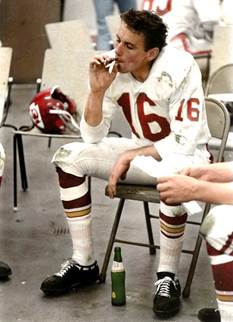
The second half, not competitive. Final score: 35-10. Smoking is not good for you. Well, and Green Bay had some magic by quarterback Bart Starr and receiver Max McGee.
The loss was not unexpected. The Packers were a traditional powerhouse and were favored by 14 points. Some good bounces boosted the score and gave coach Vince Lombardi the opportunity to denigrate the AFL: “I think the Kansas City team is a real tough football team, but it doesn’t compare with the National Football League teams.” That hurt. And would be remembered.
1967 to 1971 at Municipal Stadium: In the Spring of 1967, I graduated from law school and took the bar exam. Results would not be available until September, but I went ahead and bought my own season ticket as my pals Lochman and Graham were allowed to expand their ticket holdings. The group continued to grow, and we moved to other seats in the North Stands, about 35 rows up at the 20-yard line behind the visiting team’s bench.
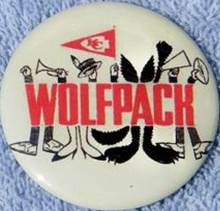
During my five years as a season ticket holder at Municipal Stadium, I saw every home game. Our seats behind the visitors bench were well located for giving a hard time to the other team, especially the hated Oakland Raiders. We were loyal to the Wolfpack tradition and sometimes had too much fun. A lot younger then. The games mostly run together in my memory, but there are two burned into my brain: the Bears in 1967 and Miami on Christmas Day in 1971. Between those games was Super Bowl IV, but I was not present for that game in New Orleans.
August 23, 1967 – Bears v. Chiefs: Days before I got my bar results, I went to my first game as a season ticket holder. Chiefs fans were still somewhat depressed over the trouncing by Green Bay in the Super Bowl. But the atmosphere at the stadium was hopeful for the first AFL-NFL contest in Kansas City. The Chicago Bears came to town for the pre-season game, and the stadium was a sell-out, but that was only 33,041 fans. It was still baseball season, so the North Stands were not yet installed. Those of us with Wolfpack seats were spread around the stadium. I sat in the stands that ran along the left field foul line – not a good seat, but I was in the room where it happened.
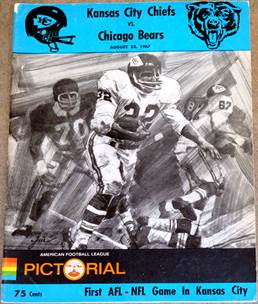
Everything went right for the Chiefs. Energized by an early 70-yard TD pass to Otis Taylor, the Chiefs kept scoring and led 29-10 at the half. They were just getting started. In the second half, the most electric play was Noland Smith’s 99-yard kickoff return with two minutes to go. The crowd noise crescendoed as “Super Gnat” scampered down the field (watch it here). Final score, 66-24.
I know that Arrowhead crowds have set some noise-level records, but the decibels that night at Municipal Stadium were so loud and joyous that you would have thought 75,000 fans were there. There was nothing more fun than getting back at the NFL. Poor George Halas, in his last year of coaching the Bears, paid the price for Vince Lombardi’s words. No one wanted to leave the stadium at the end – we just wanted to revel in the afterglow of the victory (a scene repeated in my personal memories in Game 6 of the 1985 World Series).
The rout of the Bears was not a precursor to the rest of the 1967 season. The team dropped to 9-5 and did not make the playoffs. In 1968, they had a great year, finishing 12-2. But archrival Oakland also went 12-2, forcing a tiebreaker to determine the champ in the West. The hated Raiders routed the Chiefs 41-6 and then met the Jets for the AFL title. The Jets won, and their quarterback Joe Namath guaranteed that they would also win Super Bowl III. Joe made good on his boast. The Jets defeated the Baltimore Colts, 16-7 (beating the spread by 27 points). All AFL fans celebrated.
January 11, 1970 – Super Bowl IV: In 1969, the Chiefs had another good year, finishing 11-3. This put them second behind Oakland in the West, but they caught a break. For the first time, the AFL had a 4-team playoff among the first and second place teams of each division. The Chiefs played the first place team in the East, the Joe Namath Jets, and beat them at Shea Stadium. Oakland beat Houston in the other bracket to set up an Oakland-KC title game. Kansas City came out on top this time, winning 17-7. The Chiefs headed to Tulane Stadium for the Super Bowl.
The opponent was the Minnesota Vikings, a 13-point favorite. I watched the game with some of my friends from the young Democrats, including Pat Hininger and Ray and Roz Webb. We were hosted by Millie and Lou Philpott, the parents of Pat and Roz and coincidentally owners of what passed for a big-screen TV in those days.
The Chiefs made the first three scores in the game, all field goals by Jan Stenerud. The Chiefs increased the lead to 16-0 in the second quarter when Mike Garrett scored on a 5-yard run. The play became celebrated in Super Bowl lore because coach Hank Stram was miked and his commentary is priceless. The Chiefs were “matriculating down the field” and he can be heard calling Garrett’s touchdown play, the “65 Toss Power Trap…It might pop wide open.” It did. Click here (3:48). Below, Otis Taylor (89) celebrating with Mike Garrett after Mike’s touchdown.
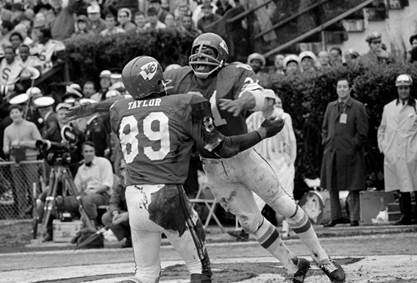
The play I remember most is the other Chiefs touchdown. The Chiefs were ahead 16-7 in the third quarter. I don’t know if a timeout had been called, but I was in the restroom. As I walked back, everyone was screaming. I had missed Lenny Dawson hitting Otis Taylor for a 46-yard touchdown. The beauty of the play, as I saw it in replay, was that the pass was only about six yards, the rest being an amazing bit of running by Taylor (see it here).
The Chiefs won 23-7, beating the spread by 29 points and proving that the Namath Jets win the prior year was no fluke. The AFL had arrived.
[Betting Spread Trivia: The bookies for the mob in KC got too many bets on the Chiefs, creating an imbalance that moved faster than they could change the betting line. Facing a big loss, mob boss Nick Civella was heard on wiretaps trying to remedy the problem. This prompted his arrest and led to a series of investigations that brought down much of the KC mob. Detailed story this week by KCUR reporters Dan Margolies and Sam Zeff (click here).]
Back in the 60s, I knew the names and numbers of almost all the players. The starters for the Super Bowl champs are listed below, and those in bold are in the Pro Football Hall of Fame.
Offense: QB Len Dawson, HB Mike Garrett, FB Robert Holmes, FL Otis Taylor, SE Frank Pitts, TE Fred Arbanas, LT Jim Tyrer, LG Ed Budde, C E. J. Holub, RG Mo Moorman and RT Dave Hill.
Defense: LDE Jerry Mays, LDT Curly Culp, RDT Buck Buchanan, RDE Aaron Brown, LLB Bobby Bell, MLB Willie Lanier, RLB Jim Lynch, LCB Jim Marsalis, RCB Emmitt Thomas, LS Jim Kearney and RS Johnny Robinson.
Place Kicker: Jan Stenerud. Punter: Jerrell Wilson. Owner: Lamar Hunt. Coach: Hank Stram.
The building of that roster has a backstory. Lamar Hunt had watched Grambling play some of its games in the Cotton Bowl. He thought that pro teams should pay more attention to the historically black colleges and hired Lloyd Wells as the first full-time black scout. The NFL was slower to do this, and remember, many top college programs (like Alabama) were still segregated when the Chiefs won the Super Bowl. The Chiefs roster for the Super Bowl had 11 players who went to historically black colleges. A majority of starting players were black (12 of 22). Lamar Hunt was a visionary in so many ways.
December 25, 1971 – The Longest Christmas Day: It was a balmy day. Game time was 4:00 PM and it was 60 degrees. Our Wolfpack crew was there, breaking up our Christmas Day. There was no way we would miss the division playoff against the Miami Dolphins. A win would get the Chiefs into the AFL title game the next Sunday.
At the half, the game was tied 10-10. At the end of the third quarter, 17-17. Each team again scored in the fourth quarter, making it 24-24.
The game looked headed for overtime when the Dolphins kicked off to the Chiefs with 1:25 to go. But Ed Podolak returned the kickoff 78 yards to the Miami 22. Three plays took it to the 15 and Jan Stenerud came in to kick the game-winning field goal. He missed. Christmas dinner was further delayed.
I’ll get back to the game, but I pause to recite the stats of Ed Podolak for the day. He had 17 carries for 85 yards. Caught 8 passes for 110 yards. Returned 3 kickoffs for 153 yards. Ran back 2 punt for 2 yards. That would be 350 yards! Without doubt, one of the greatest post-season performances ever. Below, Podolak on one of his runs with Miami’s Nick Buoniconti trying for the stop.
![]()
Although Podolak was the big star of the day, the final score was determined by two foreign-born kickers. In the first overtime, each had a chance to win the game. Jan Stenerud, a native of Norway, had a 42-yard attempt blocked. Gary Yepremian, a native of Cyprus, missed a 52-yarder.
In the second overtime, in what was the sixth quarter, Yepremian had another opportunity. The kick was from the 37-yard line, and the Sports Illustrated photo below captures the anticipation as the ball was in the air. The kick was good and the Dolphins won 27-24. It was and remains the longest game in pro football history (82 minutes, 40 seconds).

It was the Chiefs last game in Municipal Stadium. There would have been one more if they had won on Christmas Day – the AFC championship the next week. The tickets had already been issued. Mine is below. In pristine condition.

1972 – Inaugural Season at Arrowhead: With the move to Arrowhead, our group gave up our prized seats in the North Stands. Surely we would have even better seats in the bigger Arrowhead. Not. We were still on the 20 yard line, but way up in the sky – just six rows from the back of the upper deck. I bought binoculars to watch the games. Many big companies were allowed to consolidate the tickets they bought over the years and also increase their number of tickets. This forced some of the smaller groups into the nosebleed sections. Not happy campers.
So I faded from being a season ticket holder. I remained a Chiefs fan, but one mostly watching on TV. That’s not actually bad – pro football is the best TV sport and is often enhanced by replays. Also, the older I get, the more I don’t like cold weather. Or game traffic. And, especially now, I like having a restroom just down the hall. I’m still very appreciative of the fans who support the team by attending the games and shaking the stadium with cheers. The Wolfpack is now 76,000 strong.
[Stadium Trivia: When Lamar Hunt moved to KC in 1963, there was no assurance there would be a new stadium. That became a reality when Jackson County voters passed a bond issue in 1967. Initial planning was for a multi-purpose stadium, but an idea surfaced for separate stadiums for baseball and football. The Chiefs found A’s owner Charlie Finley difficult, and so joined the two-stadium camp. The full story can be found in Hot Stove #97. After the AFC championship at Arrowhead this year, New York Times sportswriter Tyler Kepner gave a nice compliment on the stadiums: “There’s something so cool about the two pro teams in Kansas City: both have had their own, terrific outdoor stadiums for decades, in the same complex, and they’ve never given in to corporate names. And I love that the whole thing is named for Harry S. Truman.” Amen.]
January 14, 1973 – Super Bowl VII: I got in one more game related to the 1972 season. Super Bowl VII in Los Angeles. I was still in my trial lawyer days at Popham and had a case requiring depositions in LA. With a cooperative opposing counsel, I was able to set them up and take in the Super Bowl. It was a good year to be there – it is still the only season that ended with a pro football team going undefeated in both the regular season and playoffs.
It was the Miami Dolphins, the team that beat the Chiefs on Christmas Day in 1971. That 1971 Miami team went to Super Bowl VI, but they lost to the Dallas Cowboys.
Miami made it back to Super Bowl VII and played the Washington Redskins. The Dolphins controlled the game and led 14-0 with two minutes to go. They had the ball and lined up for a field goal that would have made the score 17-0, a perfect match for a 17-0 season. But placekicker Garo Yepremian, the hero of the Christmas Day game, converted that dream score into a farce. The kick was blocked and Garo picked it up and sort of threw a pass. Just like his kick, the pass was blocked and went up in the air. It was caught by a Washington’s Mike Bass who ran it back for a 49-yard touchdown. Click here for the video. Luckily for Garo, there was no more scoring and Miami won 14-7.
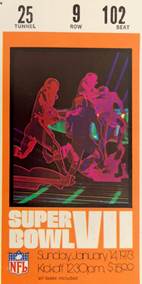
My ticket cost $15 (inflation adjusted, $86). A 2020 ticket at face value runs from $1,000 to $5,000 (much higher on the resale market). A 30-second TV commercial for Super Bowl VII was $88,000 (inflation adjusted, $550,000). That TV ad in 2020 is $5.6 million.
Miami did not make the traditional visit to the White House. Nixon was immersed in the Watergate scandal and potential impeachment. Forty years later, the undefeated 1972 Dolphins made it to the White House – at the invitation of President Obama.
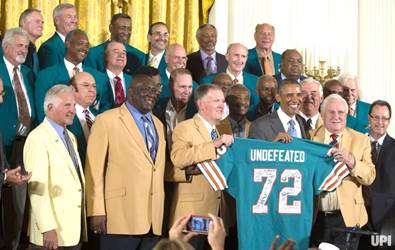
Sports Illustrated: I was a subscriber to Sports Illustrated in those days and still have these three issues: Super Bowl IV, Christmas Day and Super Bowl VII.
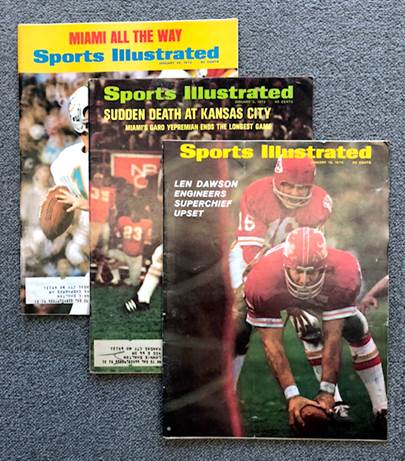
A Half-Century Later: During the 1960s, the Texans/Chiefs won the AFL title three times and went to two Super Bowls. In the next five decades, nada. Well, a few early bracket playoff victories, but never enough to get back to the big game.
This creates some time machine thoughts. A good number of Hot Stove readers were not alive the last time the Chiefs won a Super Bowl. Nor was Patrick Mahomes. Nor his parents. Jason Gay of the Wall Street Journal added some additional perspective:
“In 1970, the Super Bowl champion Chiefs went out for a pack of gum, and didn’t come back…life was different in 1970…you didn’t need to wear a seat belt in the car. You could smoke at the bank [see Lenny above]. People called you on the phone, and you actually picked it up and talked to them. Nobody wore sweatpants on an airplane. Nixon was in office. Beatles had just broken up. The Guess Who were a thing. So were The Carpenters. The top grossing film was ‘Love Story.’ Don’t act like you didn’t cry. You cried!”
So it’s time again. May Patrick join Lenny the Cool as a winning Super Bowl quarterback.
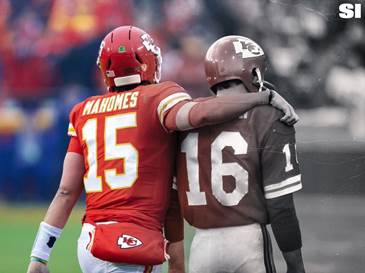
Lonnie’s Jukebox – Country Roads (From Dawson to Mahomes): In 1971, the year the Chiefs season ended on Christmas Day, one of the top songs was “Take Me Home, Country Roads” by John Denver. You can play it by clicking here, but my real purpose in this to lead to a cover of the song that was released this past fall. I missed it at the time, but Hot Stove reader Bill Wakefield recently sent it to me. There are some changes in the lyrics, and I’ll give you a hint: “Kansas City to Miami/Take me home, Pat Mahomes…” It’s well done and a nice intro for Super Bowl weekend. Click here.
I’ll take this opportunity to repost grandpa’s favorite Mahomes photo – with my granddaughter Emersyn at last summer’s Big Slick charity night at Kauffman Stadium.
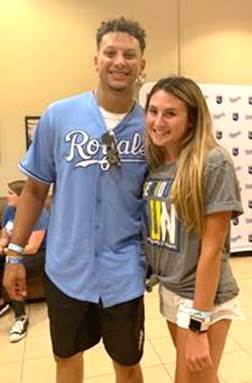
Predictions for Super Bowl LIV – A Scorigami? I only recently heard about Scorigami (website is here). A Scorigami is a score that has never happened before in the NFL. When the Chiefs beat Houston 51-31 in the divisional playoffs this year, it was a Scorigami – the first time in some 15,000 games of NFL history that this was the final score. Joe Posnanski and his podcast co-host Michael Schur are avid fans of Scorigami. When they did their predictions for this year’s Super Bowl, they picked scores that would be a Scorigami: Joe says 32-19. Michael chose 46-17. Scorigami does not pick which team wins, but Joe and Michael did. They both believe Mahomes will lead the Chiefs to a high-scoring win.
I’ll take any score with the Chiefs on top. It would certainly be fitting for the Chiefs to bring home what is now called the…Lombardi Trophy. And then show it to this crowd…
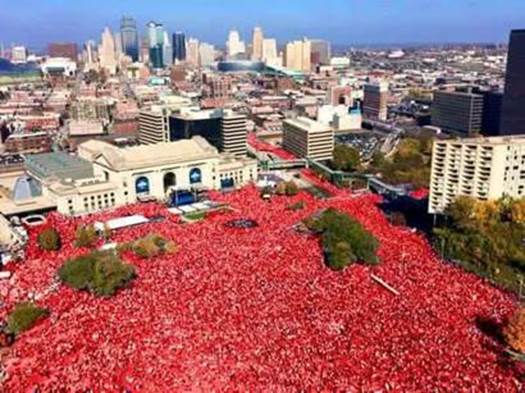
Go Chiefs!